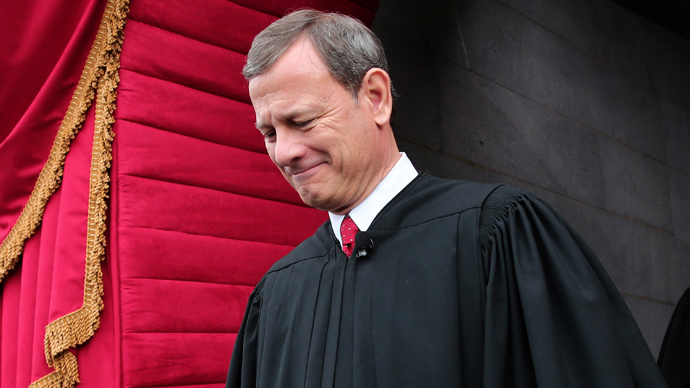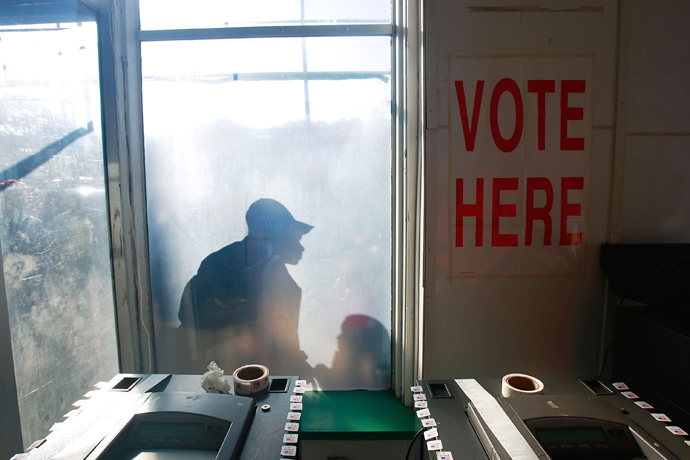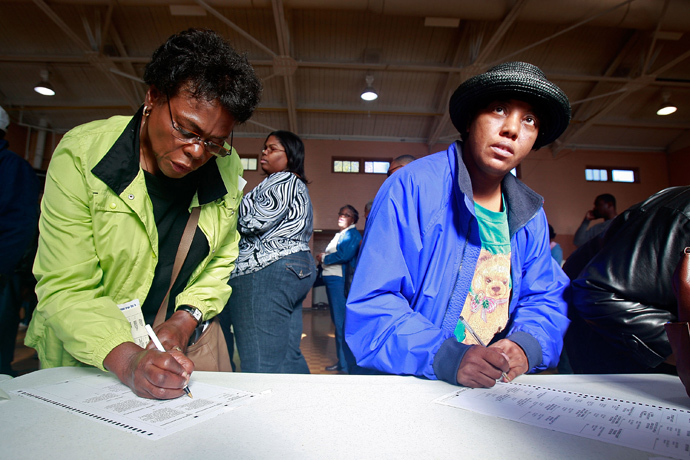Supreme Court guts Civil Rights-era voting protection, siding with 'Old Confederacy'

A divided US Supreme Court voided a central part of the Voting Rights Act, a law put in place during the Civil Rights movement to prevent historically racist states from creating obstacles to voting, Tuesday.
Chief Justice John Roberts delivered the Supreme Court’s opinion in Shelby County vs. Holder on Tuesday. The 5-4 decision, evidence of clear partisan lines in the nation’s highest court, was celebrated by Southern states and criticized by President Barack Obama for declaring federal oversight on state election changes unconstitutional. Roberts did not specify which, if any, part of the Constitution the rule violated.
Section 4 of the Voting Rights Act (VRA), invalidated by Tuesday’s decision, explained the formula used by Congress to identify regions of the US subject to extra scrutiny when local lawmakers try to change election rules. Section 4 was the precursor to Section 5, which gives the federal government the power to “preclear” any state or local changes in election rules that could potentially prevent minorities from voting.
Both the Justice Department and individual voters were able to
file suit if they believed a state or local municipality was
instituting a law that would put undue burden on a specific
demographic, a protection that saw its end on Monday.
Under the formula, Congress singled out states based on their
history of past abuses. Most of the states affected by the ruling
are in the South, where politicians frequently signed laws meant
to silence the black population by way of making their votes
count less through redistricting and other tactics. The VRA of
1965 nullified the systemic discrimination allowed by the Jim
Crow laws, adopted in the century following the abolition of
slavery.
States that prevented African Americans from, in addition to other infractions, registering to vote, voting of running for office were singled out by Section 4.
The Supreme Court’s majority ruled that, because the VRA was enacted decades ago, Congress must use updated criteria to determine which states are subject to the federal oversight. In a seeming contradiction, the Court cited the VRA’s success in protecting an equal voting system as a reason to void Section 4.

Roberts asserted that “things have changed dramatically”
over time. Since 1965 voter registration, voter turnout and the
number of African American political leaders have all vastly
increased, Roberts claimed, “in large part because of the
VRA.” Yet Roberts and four other justices called for new
criteria not “based on decades-old data” and voter
suppression methods, such as literacy tests, that have been
rendered irrelevant by Section 4.
Roberts' claims are wrong, though, some reporters pointed out on
the day.
“The regions covered by the part of the Act that was struck down, Section 4, have, in recent years, been twice as likely as those not covered to have proven violations under other sections of the Act,” wrote The New Yorker’s Amy Davidson.
Without a new formula for Section 4, which most experts agree is unlikely after years of Congressional gridlock and polarization, Section 5 of the Voting Rights Act cannot be implemented.
Roberts also wrote that Congress “cannot justify the considerable burdens created by Section 5,” despite overwhelming numbers in each chamber voting to reauthorize the VRA in 2006. In the seven years since that renewal, 31 discriminatory voting laws were blocked by Section 5, according to The Nation magazine, with six of the nine southern states covered by Section 4 enacting new voter suppression laws since 2010.
“Texas’ voter ID law, which was blocked under Section 5 by a federal court last year and could disenfranchise up to 800,000 registered voters without government-issued photo ID, will immediately go into effect,” wrote Ari Berman in The Nation. “The states of the Old Confederacy will return to the pre-1965 playbook, passing new voter suppression laws that can only be challenged, after years of lengthy litigation, in often-hostile Southern courts, with the burden of proof in those subject to discrimination, rather than those doing the discriminating.”

Mississippi Secretary of State Delbert Hosemann, who serves in one of the states previously covered by Section 4, announced Tuesday that the “process for implementation of Constitutional Voter Identification begins today.”
Chief Justice Roberts was joined in his opinion by Justices Anthony Kennedy, Antonin Scalia, Clarence Thomas and Samuel Alito. Justices Ruth Bader Ginsburg, Stephen Breyer, Sonia Sotomayor and Elena Kagan dissented. Each of the Justices in the majority was appointed by a Republican president, while the dissenters were appointed by Democrats.
President Obama said he was “deeply disappointed” by the ruling.
“Hubris is a fit word for today’s demolition of the VRA,” Ginsburg wrote in her dissent. “Congress approached the 2006 reauthorization of the VRA with great care and seriousness. The same cannot be said of the Court’s opinion today. The Court makes no genuine attempt to engage with the massive legislative record that Congress assembled … One would expect more from an opinion striking at the heart of the Nation’s signal piece of civil-rights legislation.”
Ginsburg, appointed by former president Bill Clinton in 1993, noted that the “racial polarization in voting” means the issue is especially pressing today. While Ginsburg delivered her remarks, though, Alito visibly rolled his eyes in dismissal, leading to gasps from several audience members.
“His treatment of the 80-year-old Ginsburg, 17 years his senior and with 13 years more seniority, was a curious display of judicial temperament, or, more accurately, judicial intemperance,” wrote Washington Post columnist Dana Milbank. “Typically, justices state their differences in words – and Alito, as it happens, had just spoken several hundred of his own from the bench. But Alito frequently supplements words with middle-school gestures.”
Congressional leaders pledged discussions on Section 4 over the summer, but admitted doubts over whether Republicans and Democrats would be able to agree on the issue.














